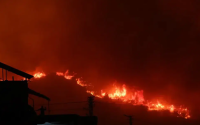8 September 2005The Sun Herald
When a slightly weakened Hurricane Katrina trudged into the Gulf of Mexico south of Naples, the ingredients were in place to cook up one of the most monstrous tempests in history.
The bath water that is the Gulf had been unusually hot, nearly 6 degrees warmer than usual for that already sweltering time of year. Making matters worse was a superheated pool of water slightly larger than South Carolina lying directly in the gathering storm's path in the central Gulf.
Feeding on the warm waters, the overgrown cloudburst mushroomed into a Category 5 colossus with top winds of 175 mph before weakening as it neared the Louisiana coast.
For the Gulf, though, Katrina was only the latest in a rash of storms on steroids. The most fearsome of its many predecessors was last year's Hurricane Ivan, a Category 5 itself in the open water.
In scientific circles, debate is raging over the possible link between warmer sea temperatures -- like those in the Gulf -- and the recent spike in severe storms. Is global warming firing up more destructive hurricanes?
"There is no question that this year (the Gulf) was warmer," University of South Florida oceanographer Frank Muller-Karger said. "Now, is that related to global warming? I don't know. I don't have the data to prove that."
'We all caught our breath'
Muller-Karger's response is typical of many researchers who study the ocean and climate. There just isn't enough evidence yet to confirm that global warming is having a significant effect on hurricanes, they say.
The going theory behind the surge in hurricane activity, which started in 1995, is that powerful storms run in 20-year or so cycles. A similar rise occurred in the 1940s and 1950s and was followed by a lull over the next two decades. If this cycle seems worse, it's because the United States' coastal population has jumped dramatically over the past half-century.
"We've seen these things before. It's part of the cycles of climate the Earth goes through," said Bob Weisberg, a professor of physical oceanography at USF.
Greenhouse gases, he added, are warming the planet, but "we can't say at this point" that global warming is intensifying hurricanes.
The warming has increased the temperature of tropical sea surfaces across the globe by 1 degree over the past 50 years.
Anyone who sought relief from the summer heat at one of Southwest Florida's beaches the week before Katrina hit Florida probably didn't return too refreshed. The temperature of the near-shore water hovered around 92 degrees.
Even the deeper waters a little farther west were more than 88 degrees, about 6 degrees warmer than they should have been.
"That's a big difference for water temperature," Muller-Karger said.
"That's why when (Katrina) came into the Gulf like that, we all caught our breath because all of us that have been out on the Gulf know it's been very hot," said Cindy Heil, a senior scientist with the Florida Fish and Wildlife Conservation Commission in St. Petersburg.
In the open Gulf, the growing storm received an even warmer reception -- literally. Three months earlier, a warm pool of water, called an eddy, had broken off the Loop Current that encircles the Gulf and wedged itself in the dead-center of the sea.
Gustavo Goni, an oceanographer with the National Oceanic and Atmospheric Administration in Miami, said he thinks that the eddy might have supercharged Katrina when the storm washed over it Aug. 28.
Eddies are a natural phenomenon in the ocean and can last for up to a year. That means the Gulf eddy could fuel more devastating storms later this season, Goni added.
Are we the cause?
The idea that global warming is to blame for stronger hurricanes is gaining a measure of traction in the scientific community. A study published in the thick of hurricane season last month by a Massachusetts Institute of Technology meteorologist is winning over converts -- and creating opponents.
After analyzing storm strength and duration, Kerry Emanuel concluded that the destructive power of hurricanes had more than doubled over the past 50 years and that global warming was at least one of the culprits.
The results were far worse than anyone had imagined.
Theory has it that a rise of 1 degree Celsius -- or 1.8 degrees Fahrenheit -- in ocean temperature will fuel a 5 percent increase in a hurricane's wind speed. Since the oceans actually rose only by a half-degree Celsius, the winds should have jumped no more than about 3 percent. When coupled with storms' longer durations, their overall destructive power should have swelled only around 12 percent.
As more carbon dioxide, methane and other greenhouse gases fill the atmosphere, hurricanes likely will get worse, though not in the near future, Emanuel said. In 10 or 15 years, this cycle of hurricanes will end, heralding a quieter era, he said.
Locally, the increasing ferocity of hurricanes probably won't be noticeable in the next 50 years. Some storms will be strong, others will be mild. But on a global scale, the difference will be apparent, Emanuel said.
At some point, he added, officials may need to climb higher on the Saffir-Simpson scale and create a Category 6 to match the gigantic storms that occasionally will form.
In the meantime, Emanuel doesn't mind that his theory hasn't caught on yet.
"Scientists don't just jump on bandwagons. They need time to digest this and question the data," he said.
NAPLES DAILY NEWS






